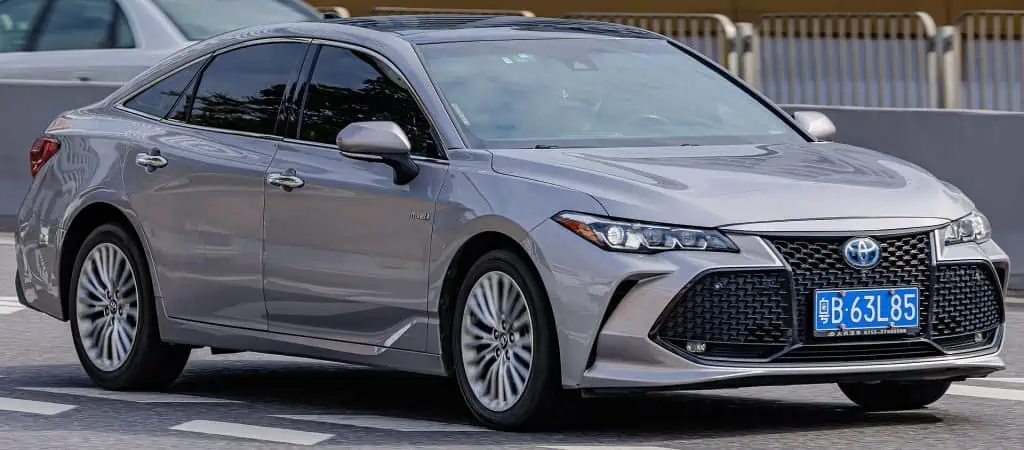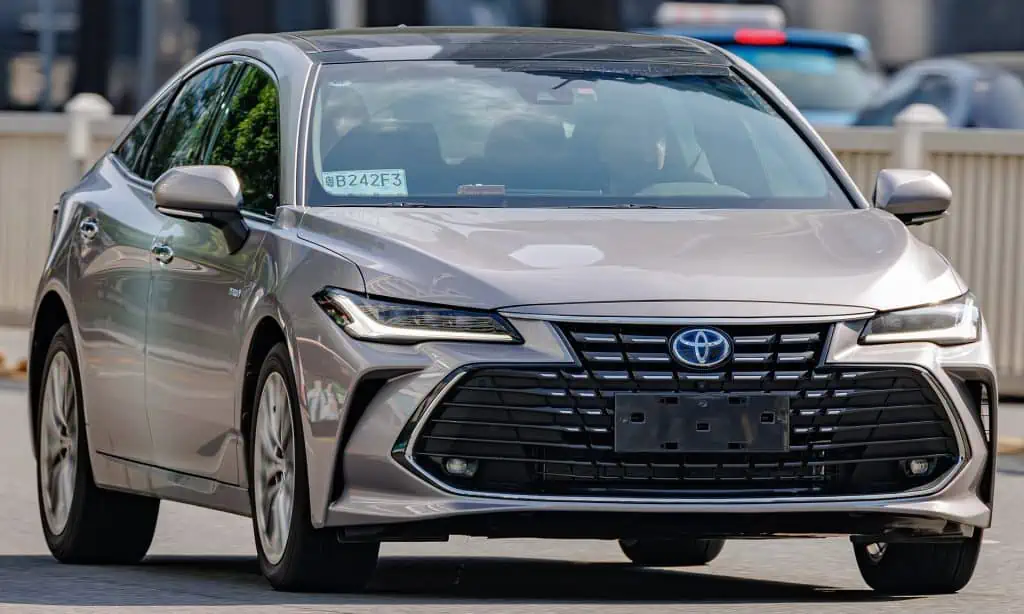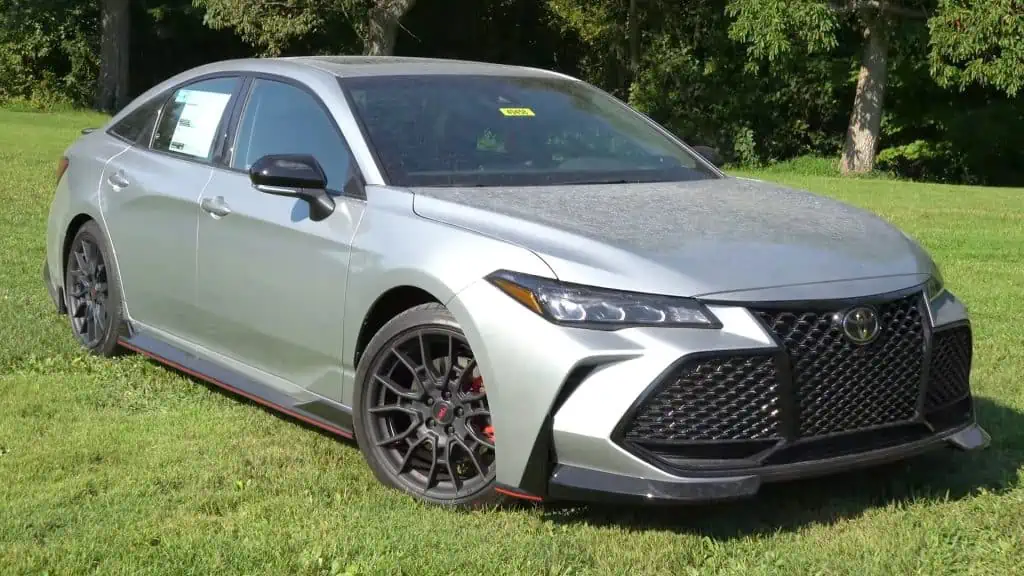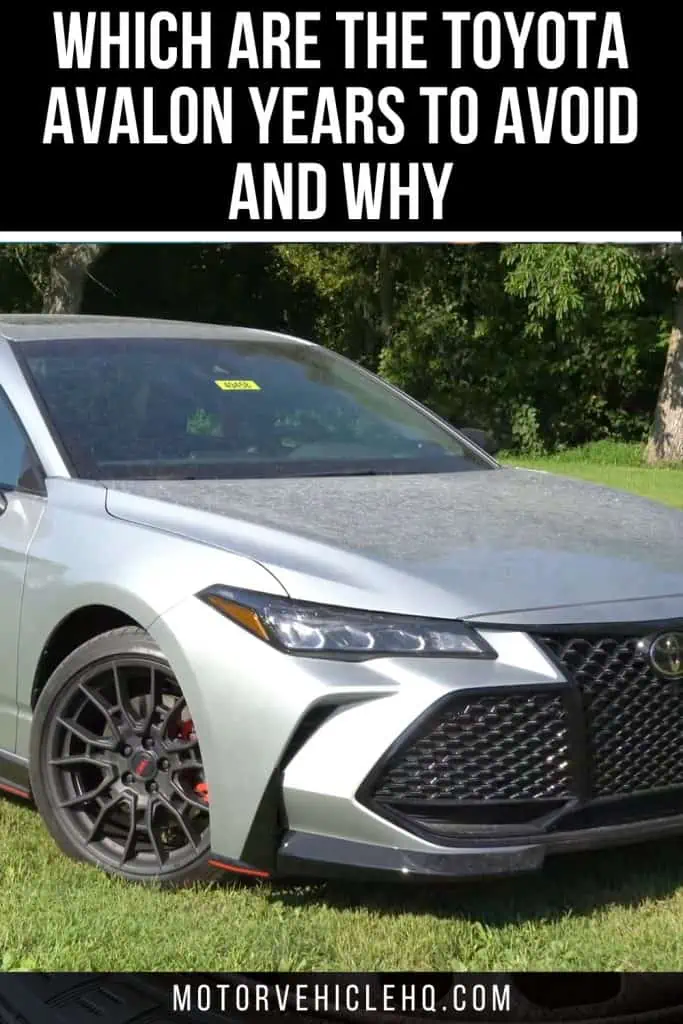Long regarded as one of the best sedans in its class, the Toyota Avalon. Avalon’s younger brothers, the Corolla, and the Camry, as well as the full-size sedan, have all been made by Toyota and have enjoyed several successful model years.
Here we are going to discuss the Toyota Avalon years to avoid as well as the top years you can consider buying.
Throughout its close to 30-year existence, the Toyota Avalon has gone through five iterations. Today, it is still being made.
The Avalon is a fantastic choice for people looking for a luxury car on a small budget that offers a peaceful, enjoyable, and smooth ride. The sedan’s top grades offer quality and features comparable to those in Lexus automobiles.
The Toyota Avalon: What Type of Car Is It?
The Avalon is Toyota’s largest front-wheel-drive sedan and the company’s flagship vehicle in the US. As a replacement for the Cressida, which was removed from the American market in 1992, the Avalon was released.
The V6-powered Avalon is a front-wheel drive sedan, whereas the upper mid-size Cressida was a rear-wheel drive vehicle and one of the automobiles that came with an inline-6.
Toyota has a tradition of naming their sedans after crown-related phrases (Crown, Corona, Camry, Corolla), various types of crowns (Tiara), or other items associated with regal status.
As a legendary island featured in Arthurian mythology, Avalon is no different. The Avalon also had a front bench seat for a while to accommodate six persons inside.
Avalons have typically been powered by V6 engines, however, hybrid four-cylinder variants have lately become available. As of 2013, the Middle East, China, South Korea, Canada, China, and the United States are the countries where the Avalon is marketed and sold. After 2022, it will no longer be used in the US.
First-Generation Toyota Avalon – 1995 to 1999
In 1991, after the Cressida was dropped from the lineup, the Camry XLE V6 took over as Toyota’s top-of-the-line sedan. When the Avalon made its debut in the fall of 1995, the Camry was no longer Toyota’s premier model. Also, it gave rise to a whole new category of vehicles that stood for the pinnacle of luxury, excellence, and elegance.
The Avalon was the most luxurious, spacious, and well-equipped vehicle the manufacturer has ever made. It was developed expressly with the needs and desires of the American market in mind at Toyota Motor Manufacturing (TMM) in Georgetown, Kentucky.
The majority of the interior and exterior design was performed by the Toyota Technical Centers (TTC) in Michigan, Arizona, and California. The original Avalon was powered by a 3.0L, 24-valve all-aluminum V6 engine adapted from the Camry.
A Toyota Avalon by Dinkun Chen / CC BY-SA 4.0. Owners of specific Toyota Avalons who purchased their vehicles between 1995 and 2016 commonly voice concerns about broken rear window sunshades. Drivers of the impacted model years claim that the sunshade generated grinding noises and needed passengers to manually push it down.
Since it had different intake and exhaust systems than the Camry, it was more potent (192 horsepower). Yet, the Avalon’s fuel efficiency was on par with the Camry’s. The 4-speed automatic transmission and improved aerodynamics received praise.
Second-Generation Toyota Avalon – 2000 to 2004
In 2000, Avalon introduced its second version, which was larger, more powerful, and more affluent in terms of technology than its predecessor. The Avalon has always been a car of firsts for Toyota. It was the first Toyota that was produced fully in America.
The US Toyota Technical Center (TTC) and the Japanese Toyota Motor Corporation (TMC) also participated in it as their first real joint venture. It was also the first Toyota model to be recognized as a domestic vehicle to meet CAFE standards.
The First Toyota car with a head engineer from both Japan and the US was the second-generation Avalon. The new Avalon’s appearance was also designed at the Toyota California design office in Newport Beach, California.
The 2000 Avalon was powered by an updated 3.0L V6 engine with Variable Valve Timing – Intelligent (VVT-i). It offered more torque and horsepower while also improving fuel economy and reducing pollutants.
The engine produced 210 horsepower at 5,800 rpm and 220 lb-ft of torque at 4,400 rpm. Its powerplant produced a fuel economy of 21/29 mpg in the city and on the highway.
Third-Generation Toyota Avalon – 2005 to 2012
In 2005, the third-generation Avalon had a complete facelift that improved performance and increased interior opulence. In North America, the Avalon underwent the quickest development of any Toyota model, lasting just 18 months from final style approval to production.
A redesigned Avalon shape for this generation was distinguished by a sleek grille with horizontal bars and character lines emphasized with chrome. The large tail lamps and expertly carved trunk of the Avalon made it simple to identify the vehicle from the rear.
Dual rear exhaust outlets added a sportier edge to the vehicle’s larger dimensions, which came from a four-inch longer wheelbase and a one-inch broader body. The Avalon now has a brand-new 3.5L, 24-valve VVT-i V6 engine with 280 horsepower and 260 lb-ft of torque.
With this engine, Toyota introduced the industry’s first roller rocker concave cam profile, which facilitated quicker valve opening and later closure. The Avalon’s power increased as a result dramatically. 22 mpg in the city and 31 mpg on the highway, according to the EPA’s estimate of fuel efficiency.
Fourth-Generation Toyota Avalon – 2013 to 2018
During the 2013 model year, the Avalon’s fourth generation was unveiled. The revised Avalon, which combines a more emotional aesthetic, increased dynamic performance, and higher refinement, assisted in the relaunch of Toyota’s flagship sedan.
The new Avalon was the most American Avalon yet because it was designed, developed, and produced in the US. Its youthful, sporty style offered a sneak peek at the “shape of Toyotas to come.”
Moreover, the Avalon was the first Toyota model to have a hybrid synergy drive. The 2013 Avalon introduced more performance and economy with a class-leading EPA-rated 25 mpg combined for the V6 and 40 mpg combined for the Avalon hybrid.
The normal Avalon’s 3.5-liter V6 engine, which produced a respectable 268 horsepower and 25 mpg combined, was still wonderfully smooth.
The inside of the brand-new 2013 Avalon was created to continue the exterior’s graceful, athletic style and to offer a premium interior experience that combines state-of-the-art technology, craftsmanship, and aesthetically sculpted surfaces.
A 2022 Toyota Avalon Hybrid by Dinkun Chen / CC BY-SA 4.0. Many owners of the 2015 Avalon redesign have mentioned that their speakers created buzzing noises when the radio’s lower bass tones were playing. Even after other drivers added more padding to address the problem, it persisted.
Fifth-Generation Toyota Avalon – 2019 to Present
The updated 2019 Toyota Avalon fills the void left by the more costly ES 350 Lexus sister and the Camry. The most recent fifth-generation model exceeded all expectations with more features, greater performance, more refinement, and more powerful engines than before.
The 2019 Avalon’s potent 301-horsepower V6 and seamless transmission provided superb acceleration. Also, an effort has been made to make the Avalon more contemporary and sporty than before.
The car handled better and looked sharper from the outside. Moreover, it included Toyota’s most sophisticated infotainment system, which supported smartphone connectivity for Apple CarPlay (if it wasn’t already accessible, you could learn how to install Apple CarPlay).
The Avalon’s interior comfort and room are still undoubtedly its best features, and the most recent model more than meets expectations.
Which are the Toyota Avalon Years to Avoid?
Certain Avalon model years have cost their owners money, been a hassle, or were even dangerous. Thankfully, we can see a clear picture of which Toyota Avalon years to avoid by looking at reports from Avalon owners.
Considering this information, we advise staying away from the following Toyota Avalon models:
- Toyota Avalon 2005
- Toyota Avalon 2006
- Toyota Avalon 2007
- Toyota Avalon 2008
- Toyota Avalon 2011
- Toyota Avalon 2013
- Toyota Avalon 2014
If you buy one of these Avalon models, you should be prepared for a greater likelihood of running into issues including fuel leaks, flaking paint, and cracked dashboards. These model years are a bad investment because of the reliability issues.
To be safe, you might wish to stay away from any Toyota Avalon from the third generation, as the majority of these model years belong to that generation.
Some of these issues can be fixed for as much as $1,000. For instance, in 2014 Avalon owners reported a risky issue with rapid acceleration that will likely cost $7,600 to fix!
There have even been reports of accidents and injuries as a result of this major problem. Anecdotal reports indicate that this may also be a problem with models from previous years, such as the 2013 model.
Likewise, the Avalon’s roof’s paint flaking was the second most frequently reported problem. It costs about $1,100 to correct this problem, which was most prevalent in the 2011 model year.
Even though this isn’t a risky problem, it is nevertheless an expensive and inconvenient visual problem that lowers the value and general appeal of your car.
Avalon vehicles have additionally experienced several recalls. The seat belt pre-tensioners and airbag deployment on the Avalon vehicles from 2012 to 2018 were problematic.
Due to an unintended pre-collision system brake activation, the 2013–2015 Avalon cars were recalled. Moreover, there were more fuel leaks in the 2014 Avalon, which increased the risk of fire and forced a recall.
Which Avalon model year is therefore the absolute worst and should be avoided at all costs? The 2006 Toyota Avalon was the poorest Avalon model and had numerous major problems, including electrical problems, steering defects, oil leaks, and engine problems.
It was also the subject of 7 recalls, ranging from the airbag inflator to the accelerator pedal. Since there are so many recalls, it’s likely that any secondhand 2006 Avalon you find on the market still needs the fixes. Of all the Toyota Avalon model years to avoid, you should avoid buying a 2006 model.
A 2022 Toyota Avalon XLE by Dinkun Chen / CC BY-SA 4.0. Several Avalon owners with automatic transmissions from 1995 to 1998, 2000 to 2007, 2009, and 2015 have complained that their vehicles won’t shift correctly. Their transmission would stutter when shifting from second to third gear when moving slowly.
Why are These Years Included In the List of Toyota Avalon Years to Avoid?
In 1994, the highly regarded automaker Toyota unveiled the Avalon, its finest front-wheel-drive model. It serves as one of its leadership role models globally.
Avalon models from particular years of experience experienced significant issues. a few engine complaints, additional interior difficulties, and other problems with several Toyota Avalon model years.
With the information in this post, you may make a firm decision regarding which model to avoid for the foreseeable future and which model years are safe to purchase.
2005
The oldest model on this list is the 2005 Toyota Avalon, which is a bad choice if you desire dependability.
Owners said that the check engine light would suddenly come on and cause major problems.
There have also been allegations of oil leaks in the engine, which can cause components to age more quickly. After an accident, other owners complained that the dashboard had fractured.
And several owners said that within the first few months of ownership, oil leaks occurred.
Overall, I believe this model shouldn’t be taken into account. Given its age and the problems, buying it is not recommended.
2006
The third-generation Toyota Avalon went on sale for the model year 2006 at that point. Although it was at first well-received, this model’s reputation suffered dramatically when customers started having problems with it.
The most frequently seen problem was an abrupt loss of power in the engine after about 60,000 miles of use. Customers also expressed concern about significant oil leaks and other flaws, including cracked dashboards and steering rack leaks, among others.
Due to its high rate of flaws and technical issues, these expensive repairs lead many to assume that the 2006 Toyota Avalon is one of the worst models ever produced.
Experts have consequently cautioned consumers not to buy a car from this model year unless they are prepared to incur considerable maintenance expenditures and take the chance that their car will continue to have mechanical problems.
Ultimately, it is evident that even while some drivers may have initially enjoyed having an Avalon from this generation, they soon had to pay for costly repairs due to a variety of defects, which significantly tarnished the reputation of the company.
It is crucial for customers looking for dependable vehicles, both new and secondhand, to think about avoiding this specific model year completely if at all feasible.
2007
Several of the same problems that beset the 2006 Toyota Avalon were present in the 2007 model when it debuted. Despite this, not many changes were taken to deal with these grave issues.
One significant problem was the propensity for dashboards to break without any obvious reason or cause. Sunshades frequently stopped working, and oil leaks were also frequent.
Despite the severity of these issues, there is one modest benefit: drivers were typically informed when a problem had emerged so that it could be fixed straight away.
Other problems mentioned included gearbox failure, harm to the oil baffle, and rattles originating from the engine area. Another model year of the Avalon has not been well received by customers, therefore it is best to avoid them to be safe.
A 2019 Toyota Avalon Hybrid Limited by Kevauto / CC BY-SA 4.0. Certain 1995-2004, 2006-2011, and 2015 Avalon automobiles have had the vapor canister emit charcoal pellets that could clog the vent valve. This issue caused the check engine lights on the affected vehicles to illuminate, and the underbelly of the engine started to smell like petrol.
If Toyota wants consumers to once again have faith in their brand and products, it must make some significant improvements with every new model release.
Customers need assurance that their vehicles will last for years rather than just a few months after purchase, and quality assurance testing should be carried out more extensively before cars are released onto the market.
2008
Customers of the Toyota Avalon had great hopes for the 2008 model year following a year of problems with their vehicle. The same issues persisted and new ones appeared, so those hopes were dashed.
Consumers claimed headlights that would suddenly burn out or go out, significant oil leaks, fractured dashboards, and rack and pinion leaks—all of which required expensive repairs due to their difficulties. For owners of Toyota Avalons, the 2008 model was a dud due to these problems and ongoing engine troubles.
The Toyota Avalon’s model year did not provide many customers with any satisfaction or value in terms of dependability or quality overall as a result of these many automobile difficulties.
2011
The 2011 model on this list has problems as well.
If you intend to keep your car with you for a while, the paint on the roof can easily peel off, which is a concern.
Moreover, the sunshade can malfunction from time to time, so you could have to drive without it.
Last but not least, it’s not ideal to try to lock yourself in before driving if the electric door locks break.
Even though the 2011 Toyota Avalon is a lot newer than the previous models, there were still much too many problems.
2013
Other model years, however, had a greater variety of complaints; the 2013 Avalon had the most problems, and correcting them cost the most money.
Customers complained that the motor failed to start for no apparent reason and was unable to find a solution. One consumer said that the problem started after the car had only traveled about 2,500 miles.
The biggest worry was the erratic rise in speed that was possible; in a few instances, vehicles crashed into obstructions as a result of speeding up on their own. When the vehicle was shipped to a manufacturer, experts were unable to diagnose the problem.
2014
Of all model years, the 2014 Toyota Avalon received the most complaints and the most expensive repairs. Consumers reported a variety of issues that appeared when their cars had just covered 2,500 kilometers.
Customers’ main issue was unexpected acceleration without any indication of a reason or cause, which frequently led to crashes with barriers.
When the vehicle was sent to a dealer for diagnosis, mechanics were unable to identify the precise source of the unpredictable behavior. Squeaky interiors and bad odors coming from the engine were two other frequent complaints.
Overall, having an Avalon of this specific model year can be expensive and time-consuming; as a result, it is better to avoid buying one if at all feasible to save money on repairs and other expenses related to maintaining an unreliable vehicle.
Which are the Toyota Avalon’s Greatest Years?
The Toyota Avalon’s best years are the ones that thousands of people have driven and tested.
Hence, instead of describing why they are superior to the other models, I will talk about their best qualities.
A 2020 Toyota Avalon TRD by Gold Pony / CC BY 3.0. Numerous 2014 Avalon owners have repeatedly complained about the vehicle’s abrupt acceleration. People’s cars were allegedly accused of accelerating quickly, going from 700 to 3600 RPM in under 1.5 seconds.
2016
Anyone who requires a vehicle with a lot of space might choose the 2016 Toyota Avalon.
The inside has room for up to five passengers to sit comfortably, and the trunk is big enough to hold most of the luggage you’ll need to take on a trip or to work.
The Avalon has respectable fuel efficiency, achieving 21 cities and 30 highway mpg.
Due to the rising cost of fuel these days, you will therefore save money on petrol each month.
2017
A dependable and effective sedan that will be a great addition to your garage is the 2017 Toyota Avalon.
It boasts a 6-speed automated transmission and a 268 HP horsepower output, giving you the speed and power you require to move from point A to point B without difficulty.
Moreover, the Avalon has precise steering, allowing you to make sharp turns at high speeds without having to worry about losing control of the car.
A smooth driving experience has also been built into this model, so you won’t have to worry about potholes or bumps ruining your day.
2018
The 2018 Toyota Avalon features a superb balance of power and efficiency in addition to a fashionable and attractive look.
It is loaded with modern features that improve your ride’s comfort and enjoyment.
It has a V6 engine that gives it power while also getting good fuel economy. The Avalon also features a modern exterior style that attracts attention everywhere it goes.
Overall, it’s a fantastic car and unquestionably a choice I’d suggest.
2020
For individuals who prefer to travel in comfort and style, the 2020 Toyota Avalon is a fantastic option.
You can have a great time driving thanks to the V6 engine’s more than 300 Horsepower.
Also, compared to earlier models, this car has a marginally improved fuel efficiency, which will enable you to save money on gas.
You won’t feel as though you’re driving a car that is either too big or too tiny for your needs because the drive is comfy.
Also, it has a lot of room, so even when the car is full of people, they won’t feel crowded.
2021
You want a car that can withstand anything life throws at it when shopping for a new one. Because of this, I believe the 2021 Toyota Avalon is a fantastic option for you.
Avalon is a fantastic automobile for 2021. It has a hybrid option that gets greater gas mileage than the average at 40 mpg.
Also, it has an all-wheel drive, which is advantageous if you live somewhere where it snows. Also, it has many safety measures, ensuring your constant protection while driving.
If you’re seeking a more recent model, I advise you all to go here.
How Reliable Is the Toyota Avalon?
Toyota cars are renowned for being highly dependable and simple to keep up with. As Toyota seems to have constantly ranked first among the most dependable brands for many years, Mazda finally passed Toyota in 2021. Toyota has a reputation for dependability, and the Avalon is no exception.
Compared to some other makes, a used Toyota is simpler to get. It appears that Toyota customers are frequently really satisfied with their autos.
Because Toyota has been at the forefront of durable engineering, people have come to have a certain amount of faith in the name. Because of this, Toyota has been around for a very long time among automakers.
A 2019 Toyota Avalon XSE by Elise240SX / CC BY-SA 4.0. Owners of Avalons from the years 1995 to 2010 as well as the 2012 redesign have claimed numerous incidents of engine misfiring. Their autos lurched and hesitated because of a defective ignition coil. The cost of replacing this component, including labor, can range from $5 to $50.
Buying a secondhand Avalon might be one of your best decisions ever. The Toyota Avalon gets a four out of five reliability rating, with an average yearly repair and maintenance cost of $463, according to Repair Pal.
It comes in third place among 12 full-size sedans and is regarded as a very dependable vehicle.
The Avalon receives a 4.0 out of 5.0 reliability rating from RepairPal, placing it third among the other 12 full-size vehicles in its category. The Avalon is predicted to have an annual ownership cost of $460, which is $130 cheaper than its rivals.
This model experiences unplanned repairs 0.4 times annually, with a 13% chance that the problem will be serious. When compared to comparable full-size cars, this is a little higher.
What Is the Lifespan of a Toyota Avalon?
Without a doubt, the Toyota Avalon has a long-range as well. iSeeCars recently looked at more than 15.8 million automobiles sold in 2019 to identify which car models have the highest percentage of vehicles that have logged 200,000 miles.
The Avalon was discovered to be the vehicle in its sector of big sedans with the longest longevity. It easily competes with vehicles that have a lifespan of more than 300,000 miles.
That’s not all, either. According to iSee Cars, 2.6% of the Toyota Avalon vehicles sold in 2019 have logged 200,000 miles. The only sedan to appear on their list of “Longest-Lasting Vehicles to Reach 200k Miles” was the Avalon. There are many explanations for why only 2.6% of Toyota Avalon vehicles sold in 2019 reached 200,000 miles.
The Avalon is after all reliable, safe, and reasonably well-built. Nevertheless, those aren’t the only things that permitted some Avalon models to drive more than 200,000 miles. How can you then make your Avalon’s odometer read more than 200,000 miles?
It’s really simple. You must carry out routine scheduled maintenance. The simplest way to ensure that your Avalon reaches the 200,000-mile milestone is with regularly planned maintenance.
Even while tasks like tire rotations and oil changes aren’t usually the most convenient, you must make sure to properly and frequently maintain your Avalon. Check out our guide to automobiles for dummies and the definition of TLC for cars if you want to understand more about what maintenance comprises.
Which are the Typical Toyota Avalon Issues?
The Toyota Avalon has experienced issues, despite being one of the brand’s flagship vehicles. The following are some of the most typical problems with this model:
1. Faulty Sunshades on the Rear Window
Certain Toyota Avalon owners who bought their cars between 1995 and 2016 frequently complain about faulty rear window sunshades. The sunshade reportedly made grinding noises and required passengers to manually push it down, according to drivers of the affected model years.
The standard solution to this problem is to replace the entire sunshade assembly. Another typical solution to get rid of the grinding noise is to remove the fuse.
2. Speaker Distortion and a Broken Infotainment System
Numerous owners of the 2015 Avalon redesign have reported that when the radio’s lower bass tones were playing, their speakers made buzzing noises. The issue persisted even after other drivers installed more padding to fix it. Owners have been urged to repair the door panel after being informed that this is a design defect.
In select 2015 Avalon models, a faulty infotainment system has also been reported. Radio, GPS, and other applications would sometimes restart, which drivers found to be quite annoying. Sometimes the screen will freeze, leaving the caller ID information visible.
3. Shifting Issues
Several automatic gearbox Avalon owners from 1995 to 1998, 2000 to 2007, 2009, and 2015 have reported that their cars won’t shift properly. When traveling at slow speeds, their transmission would stutter when changing from second to third gear.
There have also been instances where a bad throttle position sensor or shift solenoid caused the transmission to jerk or remain neutral before shifting. While the price of a new shift solenoid might range from $100 to $500 plus labor costs, the cost of replacing the throttle position sensor can range from $150 to $400.
A 2020 Toyota Avalon Limited by Kevauto / CC BY-SA 4.0. Owners of the 1996–2008 and 2012 Avalon redesigns have expressed dissatisfaction with the poor gas mileage, rough engine operation, and possibly failed emissions tests caused by their vehicles’ defective oxygen sensors. Depending on labor expenses, a replacement oxygen sensor can cost anywhere from $30 to $150.
4. A Defective EVAP Vapor Canister
Charcoal pellets that may clog the vent valve have been released from the vapor canister in some 1995–2004, 2006–2011, and 2015 Avalon vehicles.
The afflicted models’ check engine lights came on as a result of this problem, and the engine’s underside began to smell like fuel vapor.
5. Unexpected Acceleration
Many 2014 Avalon owners have complained frequently about sudden acceleration. There have been accusations that people’s cars would accelerate suddenly, going from 700 to 3600 RPM in about 1.5 seconds.
Other people have also claimed that in less than a second, their accelerator pedal moved from 27% to 79.5%. Toyota, however, asserts that no problems with the impacted cars have been found.
Often, sudden unplanned acceleration happens when a technical fault in a car causes the throttle to open without the driver pressing the gas pedal. When the driver applies the brakes, engages the cruise control, or changes gears, the vehicle may also accelerate suddenly in some circumstances.
6. Misfiring Engine
Owners of the 2012 Avalon redesign and the years 1995 through 2010 have reported numerous instances of engine misfiring. A bad ignition coil caused their cars to lurch and hesitate. In addition to labor charges, replacing this component may cost anywhere from $5 to $50.
But, keep in mind that there could be additional factors causing an engine misfire, such as a broken control module, crankshaft position sensor, or fuel injector.
The engine’s misfiring may also be brought on by mechanical issues. It is advisable to have your car examined by a qualified mechanic if your engine is misfiring to receive an accurate diagnosis.
7. Defective Oxygen Sensor
Drivers of the 1996–2008 and 2012 Avalon redesigns have complained that their vehicles’ malfunctioning oxygen sensors led to low gas mileage, harsh engine operation, and perhaps failed emissions tests. A replacement oxygen sensor usually costs between $30 and $150 plus labor costs.
8. Paint Peeling Off
Many drivers have complained about the 2011 Toyota Avalon’s roof paint peeling off. Owners have mentioned that the paint on their cars’ roofs and in the space between the sunroof and windshield bubbled.
There have also been instances where painting without using a primer resulted in the paint peeling off in sheets.
9. Engine Oil Loss
A common issue with numerous 2006 Avalon models has been engine oil loss. Due to a faulty oil pipe that allows engine oil to leak, owners have complained that their cars would make odd engine noises.
Other drivers have also complained that a large hole in the side of the engine block required towing their vehicles to a repair facility.
10. Blockages In the Idle Air Control Valve
Several 1995–2004 and 2006 Avalon owners have frequently reported experiencing problems with clogged idle air control valves.
Owners of the impacted models have noted that it took longer for their cars to idle down. Also, there have been instances where a buildup of junk in the idle air control valve has prevented the engine from accelerating below 2000 rpm.
Even though the Toyota Avalon is dependable, issues will eventually crop up as it travels farther. You may anticipate your daily driver to survive for a very long time by being familiar with the model’s most typical problems and staying on top of its maintenance requirements.
The Conclusion
We looked back at the Toyota Avalon years to avoid, and I hope you found it interesting.
It is usually advisable to get a Toyota Avalon from an appropriate model year. Also, everything that is great in the world has a drawback.
Toyota Avalon has bad apples too. Avoid buying from any of the Toyota Avalon model years if you want to get a good deal on support to avoid being previously documented.
Have your car inspected to ensure that it is safe for you and your family to use, as well as to ensure that any review information is current.
When making a buying decision, you can be confident that the information provided here is accurate and reliable.
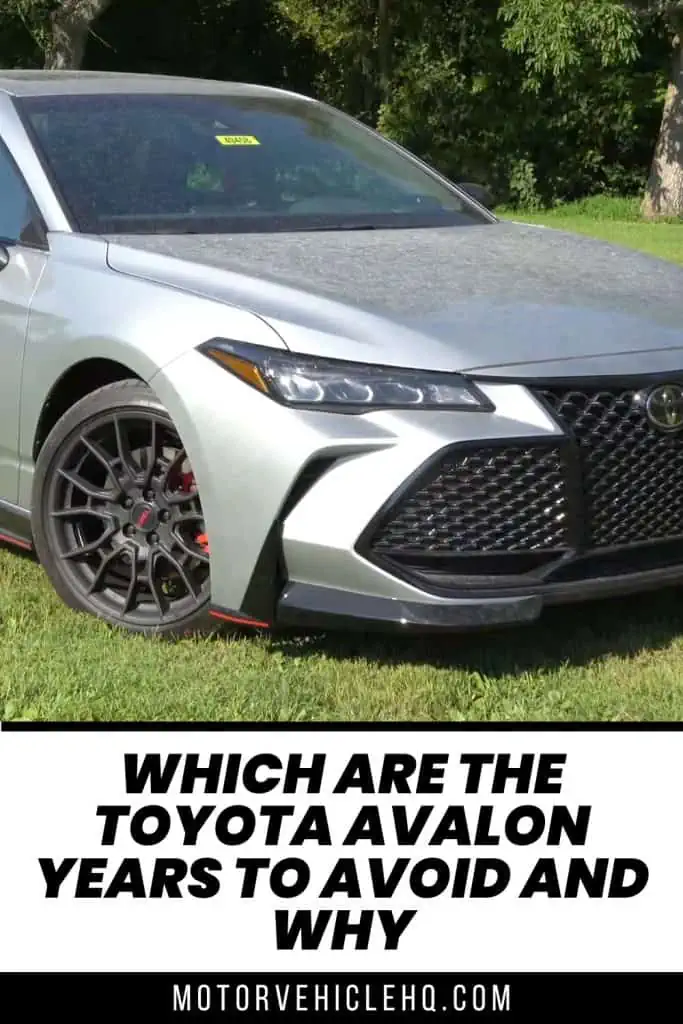
A 2020 Toyota Avalon TRD by Gold Pony / CC BY 3.0

Jim Wicks is the founder of MotorVehicleHQ. With over two decades of experience in the automotive industry and a degree in Automotive Technology, Jim is a certified car expert who has worked in various roles ranging from a mechanic, car dealership manager, to a racing car driver. He has owned more than 20 cars over the past 15 years. Ask him about any vehicle you see on the road and he can tell you the make, model and year. He loves the aesthetics of all things cars, and keeps his vehicles in pristine condition.
In his free time, Jim enjoys getting his hands dirty under the hood of a classic car or taking long drives along the country roads. His favorite car? A 1967 Shelby GT500, a true classic that, according to Jim, “represents the pure essence of American muscle.”
